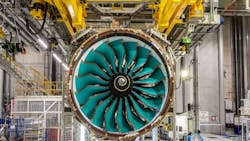ITP Aero Designs and Manufactures the First IPT Casing for the Future Rolls-Royce UltraFan
ITP Aero is carrying out the final manufacturing phase of the first IPT (Intermediate Pressure Turbine) casing of the future Rolls-Royce UltraFan, a new aircraft engine demonstrator that will define a new era in jet engines, delivering noise and fuel burn reductions, and will be 25% more efficient than a first-generation Trent engine. The casing manufacturing project is part of the CDTI and the European Union's Clean Sky 2 programme, which has been carried out over five years with the collaboration of three technology centres.
The casing, which covers the IPT of UltraFan, houses the turbine blades and connects the IPT to the rest of the engine. The IPT is a key module of UltraFan, designed to operate at very high speeds to optimize the engine's fuel consumption and minimize CO2 emissions.
The use of the new powder HIP (Hot Isostatic Pressing) technology in the casing manufacturing process has resulted in a reduction of up to 60% in the raw material required for its manufacture. The manufacturing process consists of a high-pressure and high-temperature pressing of a powdered superalloy called astroloy. The pressing is carried out inside a canister, obtaining a close to final casing geometry. The astroloy resists higher temperatures than the material used for the casings designed and manufactured so far by ITP Aero, a key requirement of UltraFan. This manufacturing method also enables a significant reduction in energy consumption compared to the traditional manufacturing method using a forge.
Erlantz Cristobal, Chief Technology Officer of ITP Aero said: "At ITP Aero, we continue to have our long term vision focused on a future in which sustainability will play a fundamental role in our sector. That is why, despite the difficult situation the aeronautic industry is going through, we continue to work towards an increasingly sustainable aviation industry, committed to developing proprietary technology and more efficient aeronautical products and services. This milestone has been achieved thanks to new manufacturing technology, which is a result of our solid network of collaboration with strategic technology centres and joint R+D centres with universities".
Collaboration with technology centres
ITP Aero has carried out the design and manufacturing process of the casing thanks to its solid network of collaboration with strategic technology centres and joint R&D&I centres with universities, created with the aim of developing advanced technologies for aeronautical engines.
The three centres that have participated are:
Aeronautics Advanced Manufacturing Center (CFAA)
The Aeronautics Advanced Manufacturing Center is a leading centre in which a public-private aeronautical manufacturing collaboration is being developed, focused on improving industrial processes and advanced machinery. This centre, led by ITP Aero and Danobat, includes the participation of more than 80 companies from the aeronautical sector, the Provincial Council of Bizkaia, the Basque Government, the University of the Basque Country and the Bizkaia Technology Park. The CFAA has carried out the design of the canisters and the machining of the casing.
Centre for Technical Studies and Research (CEIT)
The Center for Technical Studies and Research is an initiative promoted by the University of Navarra for the development of industrial projects of applied research in collaboration with R&D departments of companies. Specifically, it collaborates in projects for the development of advanced mechanical technologies for aviation. CEIT has developed the high pressure and high temperature sintering process of astroloy.
Madrid Institute for Advanced Materials Studies (IMDEA of Materials)
The Madrid Institute for Advanced Materials Studies is an initiative promoted by the Community of Madrid to foster research and technology transfer to the industrial fabric in materials science and engineering. IMDEA Materials has carried out the characterisation of the behaviour of the astroloy at containment and impact.
In addition to the three centres, the Universidad Politecnico di Torino has also participated in the definition of the heat treatments and the private company Aubert & Duval has supplied the astroloy.
UltraFan Intermediate Pressure Turbine (IPT)
In contrast to the first generation Rolls-Royce Trent engine family, in which ITP Aero participates as a risk and revenue sharing partner, UltraFan’s Low Pressure Turbine (LPT) is substituted and both the geared fan and the intermediate pressure compressor are driven by the IPT. The main technology challenge for the UltraFan IPT, is that this turbine has to deliver high power running at significant higher speeds and temperatures. To achieve this ITP Aero has drawn on its expertise in providing high-performing turbines for previous Trent engines.
UltraFan represents the next generation Rolls-Royce aero-engines suitable for widebody or narrowbody aircraft. Based on a new engine core architecture, it’s designed for maximum fuel burn efficiency and low emissions.





